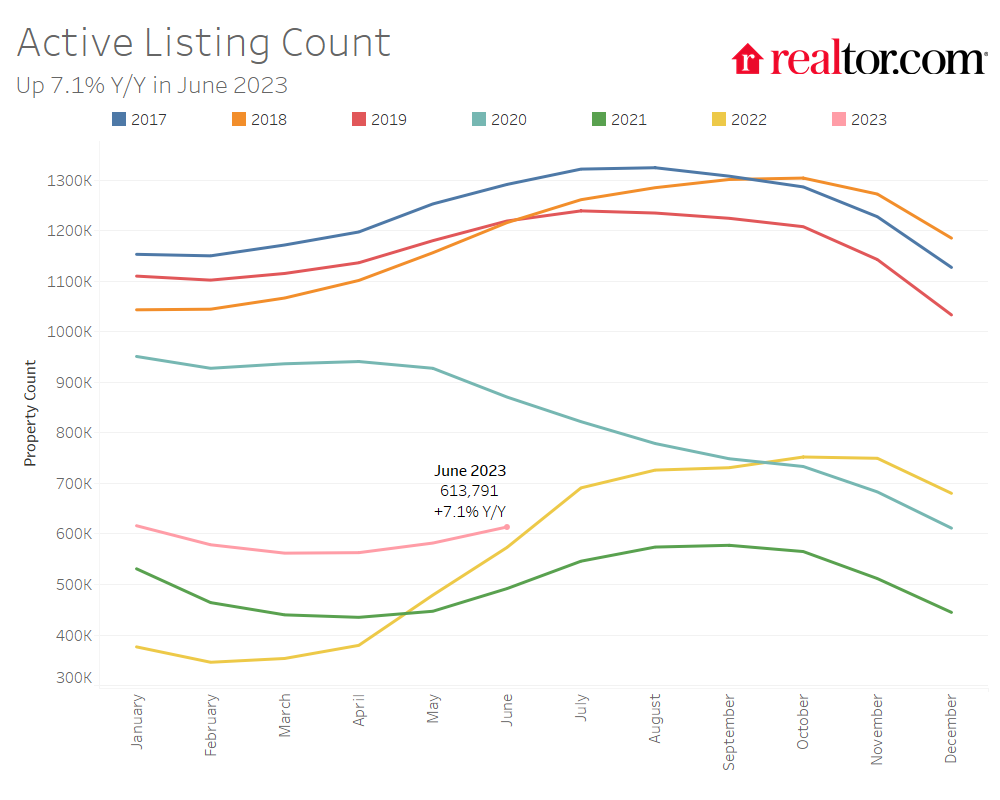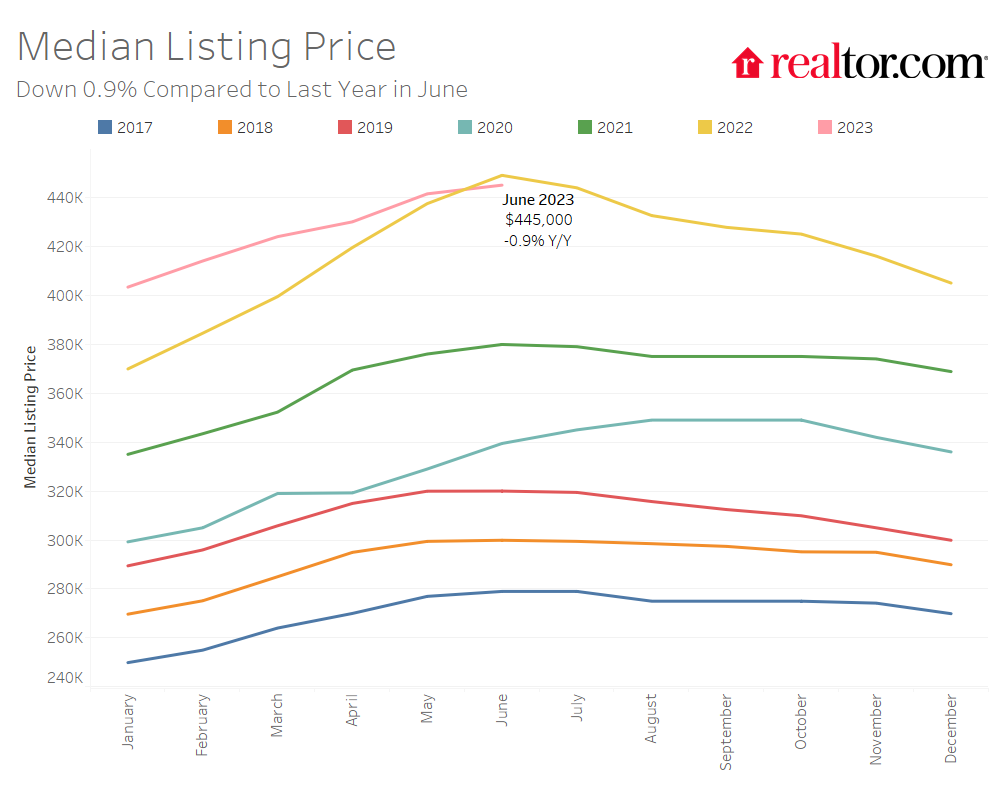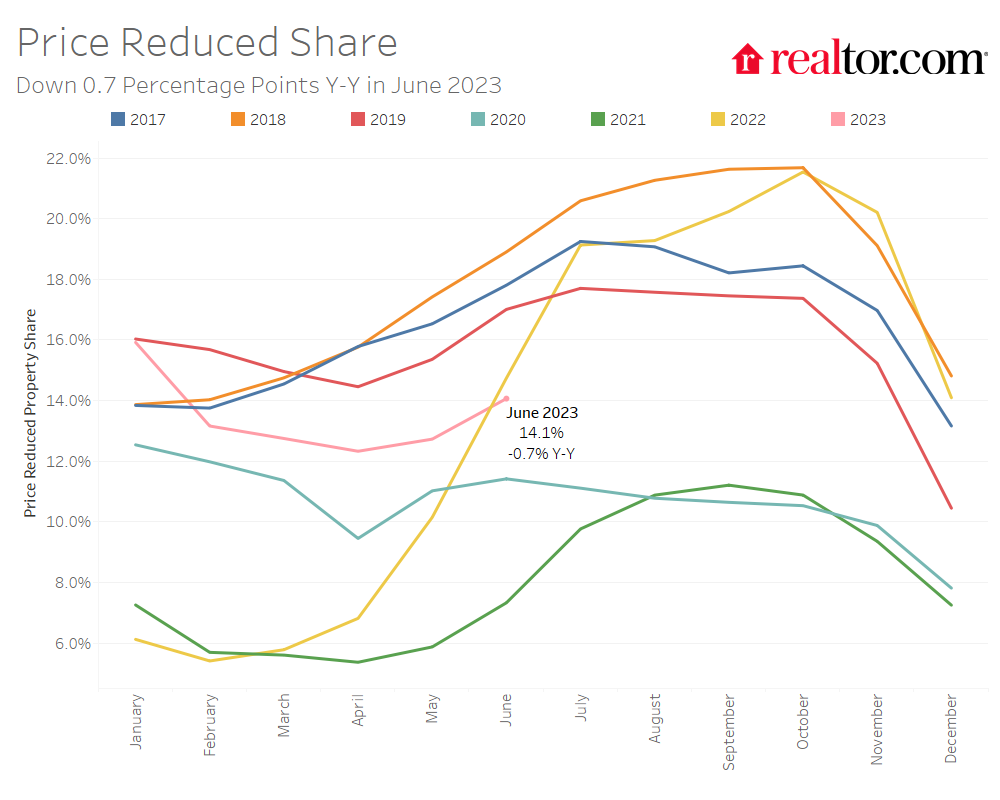June 2023 Housing Market Trends Report
- The number of homes actively for sale increased by 7.1% compared to last year.
- The total number of unsold homes, including homes that are under contract, decreased by 4.6% compared to last year.
- Home sellers were less active this June, with 25.7% fewer homes newly listed for sale compared to last year.
- The median price of homes for sale decreased by -0.9% annually in June, the first decline seen in our data trend history since 2017.
- Homes spent 44 days on the market, which is 13 days longer than last year but still shorter than before the pandemic.
According to Realtor.com®’s June housing data, growth in the inventory of homes actively for sale slowed nationally and declined in many metropolitan areas across the country as sellers continued to list fewer homes than last year and buyers competed over the remaining affordable homes for sale. While the median asking price for a home grew seasonally, we saw the first year-over-year decline in the median list price dating back to 2017, the starting point of our trend data history. Additionally, the median listing price on a per square foot basis continued to decline year-over-year for the second month in a row.
With the release of the 2023 midyear forecast, we project that housing inventory will experience a modest slip of 5% for 2023 as a whole as early year gains turn into declines in the second half of the year. As the issue of affordability persists, it will continue to create barriers to homeownership, leading to weakened demand in the housing market and dampened competition. As a result, home price growth is expected to decline at a modest rate of 0.6% for the year as a whole. Despite the decline in prices, the ongoing challenges in housing markets and stagnant buying power are anticipated to result in a 15.8% decrease in home sales for 2023.
Home Inventories Tighten in Many Areas Across the Country
There were 7.1% more homes for sale in June compared to the same time in 2022. This means that there were 41,000 more homes available to buy on a typical day this past month compared to one year ago. However, the inventory growth rate for homes actively for sale continued to slow for the fourth month in a row, registering less than half of May’s 21.5% rate. In the final week of June, we noted that inventory actually declined on a year-over-year basis for the first time since last April. This substantial slowdown was primarily driven by fewer potential sellers opting to list their home and the market which lapped the period of higher inventory growth that started in May of last year. The mortgage-rate-driven reset in housing inventory as both buyers and sellers recalibrated expectations to rising rates began in April 2022 and continued until the end of the year. Specifically, active listings rose from May to June 2022 by 19.7% or 94,000 more homes. Monthly inventory growth this June was only 5.5% or 32,000 more than May 2023–closer to the 3.8% typical May to June increase that we saw in 2017-2019. In addition, there were fewer homes available to buy on a typical day in June than there were a few years ago.

The total number of homes for sale, including homes that were under contract but not yet sold, decreased by 4.6% compared to last year. This is the second month in a row that total listings have declined on a year-over-year basis.

The number of homes under contract (pending listings) declined by 16.7% compared to the same time last year. This is slightly lower than May’s 18.1% decline and much improved from December’s peak decline (-36.9% year-over-year).The stabilization and improvement in pending home sales continues to support that the market has moved past its bottom and is making a slow and bumpy recovery as home buyers adjust to higher rates and may start to reenter the market gradually. In May, existing home sales increased 0.2% as the pace of home sales continues to exceed the 4 million sales low reached in January. In fact, a recent survey carried out by Realtor.com and Censuswide found that despite the high prices and elevated mortgage rates faced by home buyers, the vast majority of respondents (88% of those shopping) still hope to make a home purchase happen.

In May, home selling sentiment as measured by Fannie Mae’s Home Purchase Sentiment Index (HPSI) continued to improve for a third month in a row. The net share of survey respondents who said now is a good time to sell increased by 8 percentage points compared to the previous month. However, the measure is still 26 percentage points lower than the prior year. This more positive seller sentiment has yet to translate to more newly listed homes. In June, the number of homes newly-listed for sale declined by 25.7% compared to the same time last year. This was a faster rate of decline than May’s 22.7% decrease and new listings remained 27.6% below pre-pandemic 2017 to 2019 levels. During the first half of 2023, there were 20.1% fewer newly listed homes for sales on a typical day compared to the first half of 2022. The difference was more pronounced when compared to the first-half in the pre-pandemic years (2017 to 2019). In fact, the pace of new home listings year to date is even 16.4% lower than in the first half of 2020 when the real estate market was still contending with pandemic-era closures, restrictions, and uncertainties, highlighting just how short-on-new-options buyers in today’s market really are.

The number of homes for sale in the 50 largest metro areas in the U.S. increased by 2.8% compared to last year although inventory in this group of metro areas as a whole is still 47.1% below pre-pandemic levels. Among larger metros, inventory growth is currently driven almost exclusively by the South. The Southern region saw the most growth in the number of homes for sale, with a 24.1% increase compared to last June. However, home inventory in the South was still 41.0% below pre-pandemic levels. Large metros in all the other three regions saw declining annual growth in active inventory. The inventory of homes for sale in the Midwest saw its first year-over-year decline in many months (-5.5%), and it was less than half of pre-pandemic levels (down 53.2%). In the West, large metro inventory declined by 20.9% compared to last year and it was 42.1% below pre-pandemic levels. Inventory declined by 13.4% year-over-year in the Northeast where it was 61.5% below pre-pandemic levels.
The Midwest saw listing activity decline by 23.4% compared to the previous year, while they declined by 24.6% in the Northeast, 26.2% in the South, and 33.7% in the West. In all regions newly-listed homes remained well below the typical levels seen in 2017 to 2019.
Inventory decreased in 28 out of 50 of the largest metros compared to last year. However, some Southern metros saw significant inventory growth such as San Antonio (+65.7%), Nashville (65.53.3%) and New Orleans (60.0%). Despite high inventory growth compared to last year, most southern metros still had a lower level of inventory when compared to pre-pandemic years. In fact, among the 50 largest metro areas only Austin (+5.0%) saw higher levels of inventory in June compared to typical 2017 to 2019 levels.
In June, none of the 50 largest metro areas saw new listings increase over the previous year. Western markets reported the largest yearly declines, including in Phoenix (-47.8%), Seattle (-37.0%), and San Diego (-36.7%).
Homes Are Spending More Time on the Market Than Last Year
The typical home spent 44 days on the market this June which is almost two weeks longer than the same time last year, but homes still spent 10 fewer days on the market this June than they did in the average June from 2017 to 2019. In other words, in most areas the housing market continues to move much faster than it did in the pre-pandemic era despite significant slowing from the frenzied pace of the past couple years.
In the 50 largest metropolitan areas in the United States, the typical home spent 37 days on the market, 11 days more than the previous June. This trend was seen across all regions, with larger metros in the South seeing the greatest increase (+15 days), followed by the West (+9 days), Northeast (+7 days) and Midwest (+6 days). Homes in Western metros were also spending 1 more day on the market than pre-pandemic times, but in all other regions homes were still selling more quickly.
All of the 50 largest metros saw an increase in time on market compared to the previous year. Time on market increased the most in Raleigh (+26 days), Austin (+25 days), and Miami (+25 days). Eight predominantly Western markets saw homes spend more time on the market than typical 2017 to 2019 timing. Seattle (+6 days), Kansas City (+4 days), and San Francisco (+4 days), saw the greatest increase in time on market compared to average 2017 to 2019 pacing.

Median Listing Price Sees First Decline
The national median list price grew to $445,000 in June, up from $441,000 in May. However, it was down from a record high of $449,000 in June 2022 (-0.9%) , representing the first yearly decline since the starting time of our trend data (2017 onward). This mirrors trends in the median home sales price which declined in February 2023 for the first time in nearly 11 years and shrank on an annual basis for the fourth month in a row in May. In June, the median listing price on a square foot basis continued to decline compared to last year, dipping for the second month in a row, by 1.0%.
However, higher mortgage rates compared to June of last year increased the monthly cost of financing 80% of the typical home by roughly $258 (+12.6%) compared to a year ago. This far outpaces wage growth (+4.3%) and inflation (+4.0%) but the rate of growth is slowing compared to last month’s 15.5% figure as listing prices declined and interest rate growth slowed.

The percentage of homes with price reductions decreased from 14.7% in June of last year to 14.1% this year. The share of price reductions remains below typical levels seen in 2017 to 2019. This level of price reductions suggests that there isn’t a great mismatch between buyer and seller expectations than is typically expected.

In the largest metropolitan areas in the country, the combined annual median list price growth rate for active listings was 5.4%, outpacing the national rate. Northeastern metros had the highest growth rate in active listing prices, with an average increase of 11.7% over the past year. Prices in Cincinnati (+20.0%), Rochester (+19.6%), and Los Angeles (+17.7%) saw the biggest increases among large metros. However, in each of these metros the mix of inventory changed as larger and more expensive homes were listed for sale in June compared to the previous year. On a price-per-square-foot basis, listing prices only grew by 9.7% in Cincinnati, 11.4% in Rochester, and 6.7% in Los Angeles. Fourteen out of the largest 50 markets saw their median list price decline. The greatest year-over-year price declines were seen in Austin (-6.8%), Houston (-5.1%), and Raleigh (4.2%).
Large southern metros saw the largest increase in the percentage of homes with price reductions (+1.3 percentage points), followed by large midwestern metros (+0.5 percentage points). San Antonio (+8.3 percentage points), Memphis (+6.3 percentage points) and Jacksonville (+4.7 percentage points) had the largest increases in the percentage of homes with price reductions compared to last year.
June 2023 Regional Statistics (50 Largest Metro Combined Average)
| Region | Active Listing Count YoY | New Listing Count YoY | Median Listing Price YoY | Median Listing Price Per SF YoY | Median Days on Market Y-Y (Days) | Price Reduced Share Y-Y (Percentage Points) |
| Midwest | -5.5% | -23.4% | 9.6% | 5.8% | 6 | +0.5 pp |
| Northeast | -13.4% | -24.6% | 11.7% | 6.4% | 7 | -1.5 pp |
| South | 24.1% | -26.2% | 1.5% | 1.1% | 15 | +1.3 pp |
| West | -20.9% | -33.7% | 4.4% | 1.1% | 9 | -6.8 pp |
June 2023 Regional Statistics vs Pre-Pandemic 2017-2019 (50 Largest Metro Combined Average)
| Region | Active Listing Count vs Pre-Pandemic | New Listing Count vs Pre-Pandemic | Median Listing Price vs Pre-Pandemic | Median Listing Price Per SF vs Pre-Pandemic | Median Days on Market vs Pre-Pandemic (Days) | Price Reduced Share vs Pre-Pandemic (Percentage Points) |
| Midwest | -53.2% | -28.6% | 32.7% | 41.7% | -8 | -6.9 pp |
| Northeast | -61.5% | -32.6% | 39.8% | 48.2% | -13 | -9.2 pp |
| South | -41.0% | -21.5% | 36.3% | 53.0% | -9 | -4.1 pp |
| West | -42.1% | -37.4% | 39.6% | 50.2% | 1 | -5.0 pp |
June 2023 Housing Overview by Top 50 Largest Metros
| Metro Area | Median Listing Price | Median Listing Price YoY | Median Listing Price per Sq. Ft. YoY | Active Listing Count YoY | New Listing Count YoY | Median Days on Market | Median Days on Market Y-Y (Days) | Price Reduced Share | Price Reduced Share Y-Y (Percentage Points) |
| Atlanta-Sandy Springs-Alpharetta, Ga. | $439,000 | -2.2% | -0.4% | 9.5% | -29.1% | 40 | 13 | 13.6% | -0.5 pp |
| Austin-Round Rock-Georgetown, Texas | $580,000 | -6.8% | -5.3% | 47.8% | -31.1% | 45 | 25 | 33.0% | 1.1 pp |
| Baltimore-Columbia-Towson, Md. | $366,000 | 0.7% | 3.9% | -18.2% | -24.0% | 36 | 6 | 10.8% | -2.0 pp |
| Birmingham-Hoover, Ala. | $300,000 | 0.5% | 3.6% | 22.8% | -22.4% | 43 | 14 | 12.2% | 1.8 pp |
| Boston-Cambridge-Newton, Mass.-N.H. | $866,000 | 15.5% | 9.4% | -15.9% | -30.0% | 24 | 7 | 12.0% | -2.3 pp |
| Buffalo-Cheektowaga, N.Y. | $278,000 | 13.5% | 9.9% | -3.8% | -18.1% | 31 | 10 | 7.1% | 0.3 pp |
| Charlotte-Concord-Gastonia, N.C.-S.C. | $441,000 | 0.1% | 2.5% | 10.4% | -34.9% | 38 | 12 | 12.6% | 0.0 pp |
| Chicago-Naperville-Elgin, Ill.-Ind.-Wis. | $382,000 | 6.3% | 0.2% | -23.4% | -26.4% | 34 | 5 | 9.7% | -2.8 pp |
| Cincinnati, Ohio-Ky.-Ind. | $390,000 | 20.0% | 9.7% | -1.7% | -22.4% | 30 | 8 | 10.3% | 0.8 pp |
| Cleveland-Elyria, Ohio | $248,000 | 10.4% | 4.8% | -9.4% | -25.1% | 38 | 5 | 10.5% | 0.5 pp |
| Columbus, Ohio | $399,000 | 14.1% | 6.3% | -1.3% | -24.5% | 23 | 7 | 14.4% | 2.3 pp |
| Dallas-Fort Worth-Arlington, Texas | $473,000 | -3.5% | -3.6% | 30.1% | -26.4% | 36 | 14 | 20.5% | 3.8 pp |
| Denver-Aurora-Lakewood, Colo. | $680,000 | 0.0% | 4.0% | 6.1% | -26.1% | 29 | 13 | 20.3% | -1.2 pp |
| Detroit-Warren-Dearborn, Mich. | $270,000 | -3.6% | -0.3% | -15.9% | -27.7% | 31 | 8 | 14.2% | -2 pp |
| Hartford-East Hartford-Middletown, Conn. | $434,000 | 17.4% | 3.5% | -27.9% | -24.9% | 18 | 1 | 5.9% | -0.7 pp |
| Houston-The Woodlands-Sugar Land, Texas | $379,000 | -5.1% | -2.4% | 23.6% | -20.9% | 40 | 9 | 16.2% | 0.0 pp |
| Indianapolis-Carmel-Anderson, Ind. | $350,000 | 9.4% | 6.7% | 18.3% | -24.9% | 36 | 10 | 16.9% | 3.9 pp |
| Jacksonville, Fla. | $439,000 | -0.1% | -1.7% | 39.3% | -27.8% | 45 | 17 | 18.7% | 4.7 pp |
| Kansas City, Mo.-Kan. | $453,000 | 13.6% | 11.1% | 11.1% | -24.8% | 50 | 12 | 12.0% | 3.8 pp |
| Las Vegas-Henderson-Paradise, Nev.* | $455,000 | N/A | N/A | N/A | N/A | 45 | N/A | 13.6% | N/A |
| Los Angeles-Long Beach-Anaheim, Calif. | $1,172,000 | 17.7% | 6.7% | -20.8% | -30.8% | 39 | 9 | 8.7% | -6.0 pp |
| Louisville/Jefferson County, Ky.-Ind. | $325,000 | 8.3% | 6.8% | -4.4% | -23.5% | 29 | 7 | 13.3% | -0.4 pp |
| Memphis, Tenn.-Miss.-Ark. | $327,000 | 7.3% | 2.6% | 59.4% | -18.9% | 44 | 14 | 16.2% | 6.3 pp |
| Miami-Fort Lauderdale-Pompano Beach, Fla. | $605,000 | -3.2% | 1.6% | 30.4% | -28.8% | 62 | 25 | 12.7% | 1.0 pp |
| Milwaukee-Waukesha, Wis. | $380,000 | 13.5% | 10.2% | -25.0% | -22.6% | 29 | 2 | 8.6% | -1.7 pp |
| Minneapolis-St. Paul-Bloomington, Minn.-Wis. | $460,000 | 8.9% | 3.8% | -4.7% | -17.8% | 31 | 3 | 11.2% | 0.2 pp |
| Nashville-Davidson-Murfreesboro-Franklin, Tenn. | $591,000 | 5.2% | 1.3% | 63.3% | -24.9% | 34 | 19 | 20.8% | 3.5 pp |
| New Orleans-Metairie, La. | $345,000 | -1.4% | -0.2% | 60.0% | -18.7% | 58 | 19 | 20.1% | 2.2 pp |
| New York-Newark-Jersey City, N.Y.-N.J.-Pa. | $749,000 | 11.0% | 17.7% | -14.3% | -26.7% | 51 | 12 | 8.2% | -2.3 pp |
| Oklahoma City, Okla. | $350,000 | 8.7% | 0.8% | 29.3% | -24.1% | 45 | 15 | 15.4% | 4.5 pp |
| Orlando-Kissimmee-Sanford, Fla. | $459,000 | -1.2% | -0.5% | 21.4% | -29.0% | 46 | 18 | 14.9% | 0.8 pp |
| Philadelphia-Camden-Wilmington, Pa.-N.J.-Del.-Md. | $355,000 | 1.9% | 2.9% | -13.9% | -26.0% | 45 | 10 | 11.5% | -1.5 pp |
| Phoenix-Mesa-Chandler, Ariz. | $540,000 | -1.4% | -4.9% | -16.0% | -47.8% | 44 | 21 | 19.8% | -9.5 pp |
| Pittsburgh, Pa. | $240,000 | 0.2% | -3.7% | -0.9% | -18.9% | 47 | 10 | 14.2% | -0.5 pp |
| Portland-Vancouver-Hillsboro, Ore.-Wash. | $640,000 | 6.7% | -0.5% | 8.1% | -25.1% | 34 | 10 | 16.1% | -5.2 pp |
| Providence-Warwick, R.I.-Mass. | $550,000 | 14.5% | 0.2% | -19.4% | -33.6% | 31 | 9 | 6.4% | -2.8 pp |
| Raleigh-Cary, N.C. | $479,000 | -4.2% | -3.2% | 19.8% | -33.2% | 43 | 26 | 12.3% | -1.3 pp |
| Richmond, Va. | $442,000 | 12.4% | 8.4% | 1.9% | -27.4% | 40 | 9 | 7.1% | -0.4 pp |
| Riverside-San Bernardino-Ontario, Calif. | $580,000 | -3.2% | 1.0% | -18.1% | -35.5% | 44 | 13 | 11.9% | -7.6 pp |
| Rochester, N.Y. | $274,000 | 19.6% | 11.4% | -11.3% | -18.9% | 12 | 1 | 7.0% | -2.2 pp |
| Sacramento-Roseville-Folsom, Calif. | $679,000 | 5.6% | -2.9% | -33.4% | -31.1% | 33 | 4 | 12.4% | -12.3 pp |
| San Antonio-New Braunfels, Texas | $367,000 | -3.9% | -2.0% | 65.7% | -18.3% | 47 | 17 | 22.7% | 8.3 pp |
| San Diego-Chula Vista-Carlsbad, Calif. | $1,095,000 | 15.4% | 6.2% | -35.9% | -36.7% | 31 | 7 | 10.7% | -7.1 pp |
| San Francisco-Oakland-Berkeley, Calif. | $1,150,000 | 0.4% | -1.0% | -30.0% | -33.7% | 32 | 8 | 10.1% | -4.7 pp |
| San Jose-Sunnyvale-Santa Clara, Calif. | $1,498,000 | 0.2% | -0.8% | -44.1% | -33.0% | 29 | 5 | 8.1% | -9.1 pp |
| Seattle-Tacoma-Bellevue, Wash. | $825,000 | 2.8% | 3.3% | -25.1% | -37.0% | 29 | 7 | 12.5% | -5.8 pp |
| St. Louis, Mo.-Ill. | $289,000 | 3.5% | 5.1% | -3.1% | -18.2% | 39 | 7 | 10.3% | -0.1 pp |
| Tampa-St. Petersburg-Clearwater, Fla. | $445,000 | -1.0% | 0.6% | 30.5% | -29.0% | 46 | 20 | 18.8% | 0.5 pp |
| Virginia Beach-Norfolk-Newport News, Va.-N.C. | $395,000 | 12.9% | 6.5% | -9.6% | -27.8% | 29 | 6 | 11.5% | -1.5 pp |
| Washington-Arlington-Alexandria, DC-Va.-Md.-W. Va. | $644,000 | 9.2% | 4.9% | -26.3% | -30.2% | 32 | 6 | 9.1% | -5 pp |
*Some Las Vegas listing metrics have been excluded while data is under review.
Methodology Note:
With the release of its May 2023 Housing Report, Realtor.com® incorporated a new and improved methodology for capturing and reporting housing inventory trends and metrics. As a result of these changes, this release is not directly comparable with previous data releases and reports. However, future data releases, including historical data, will consistently apply the new methodology.
Subscribe to our mailing list to receive updates and notifications on the latest data and research.


